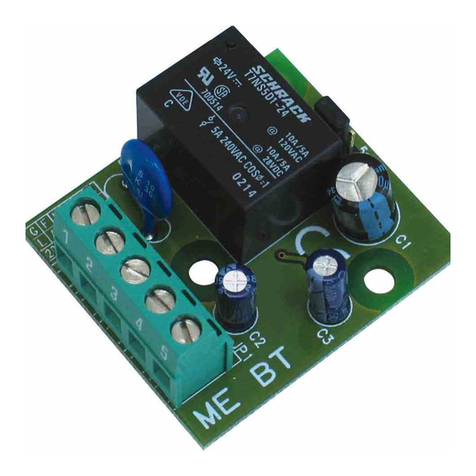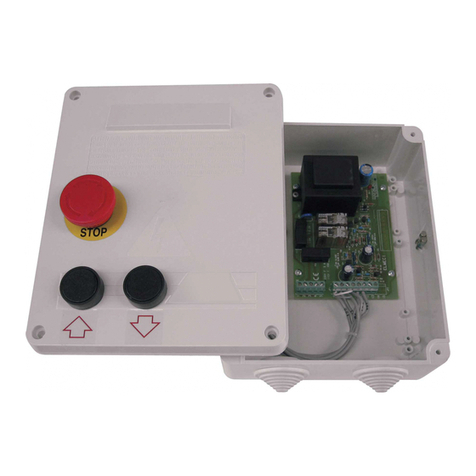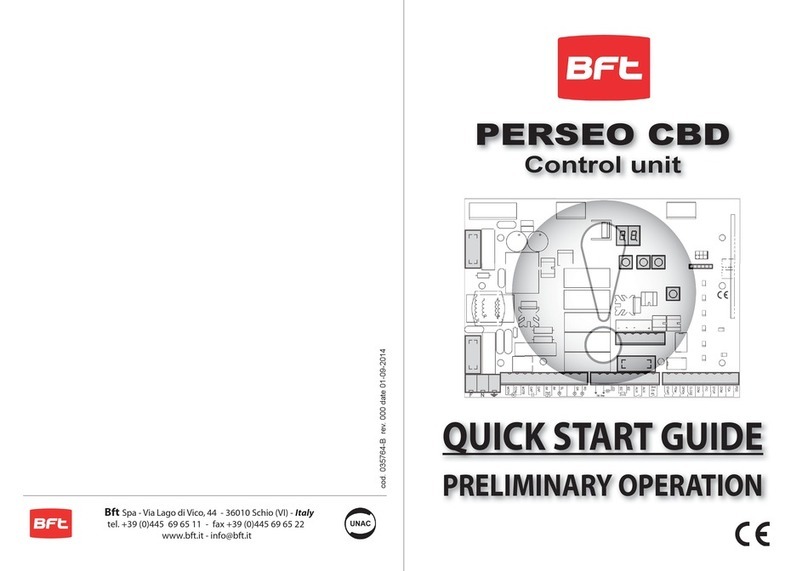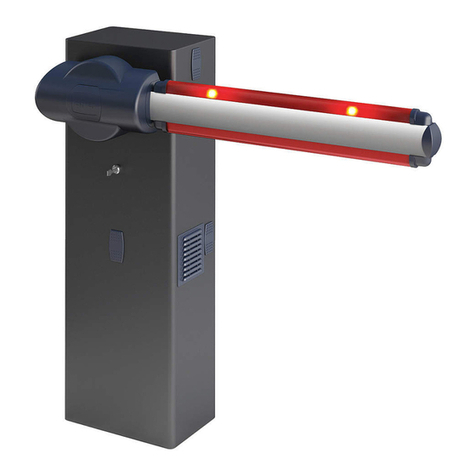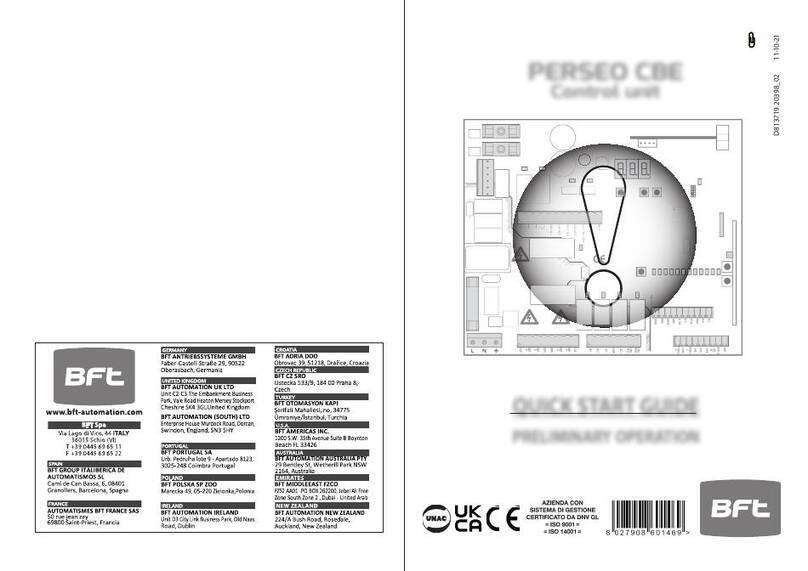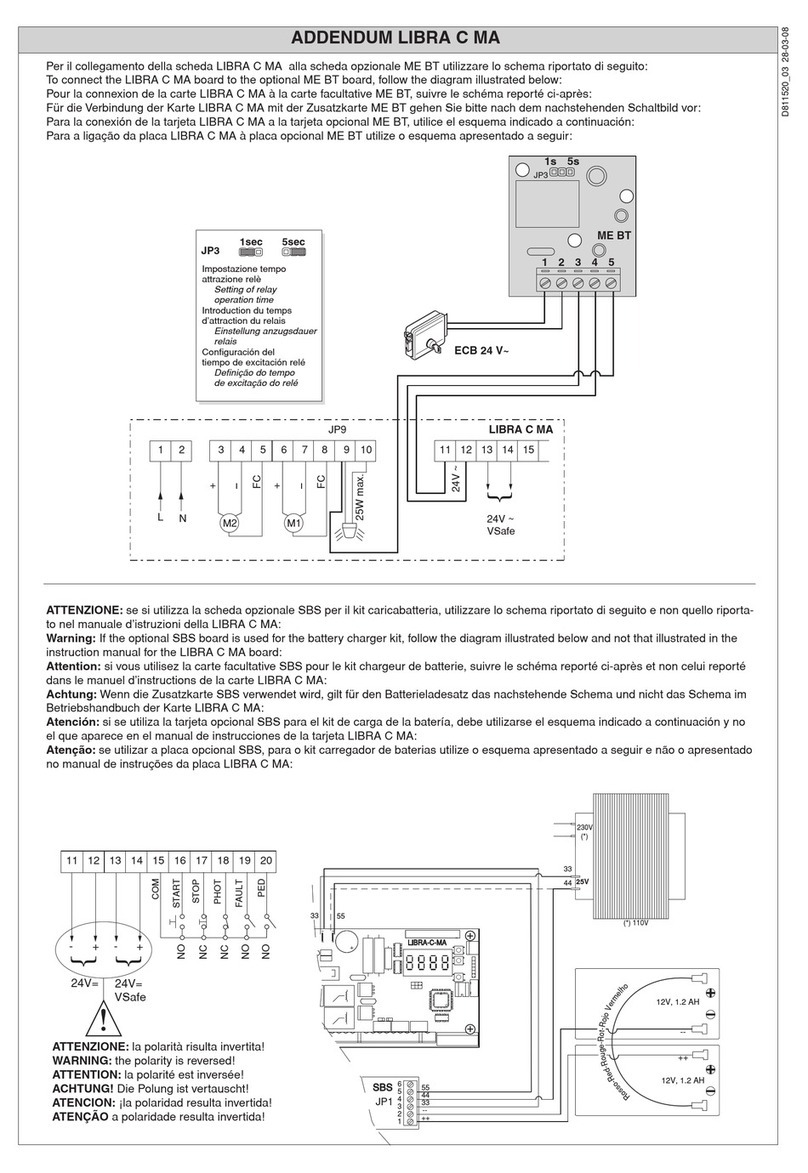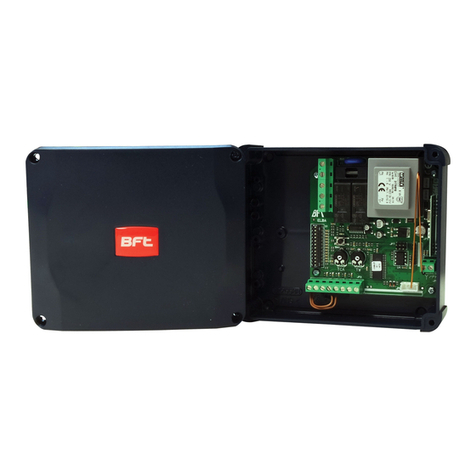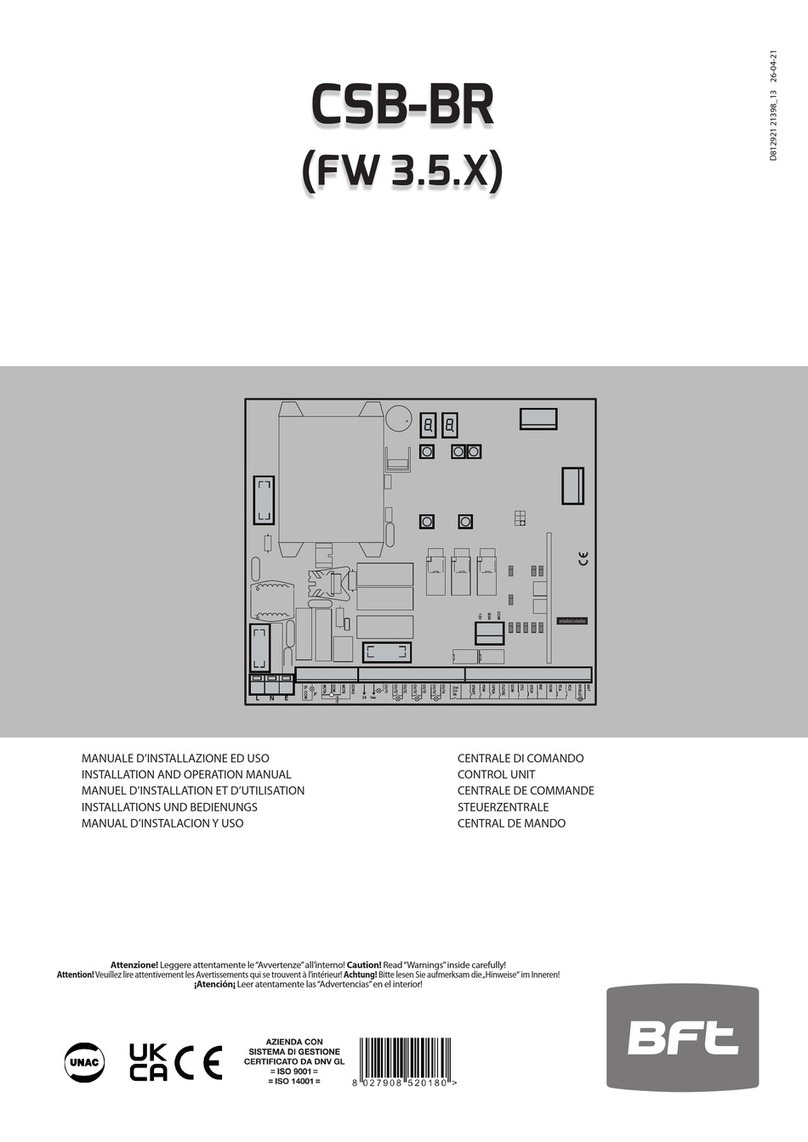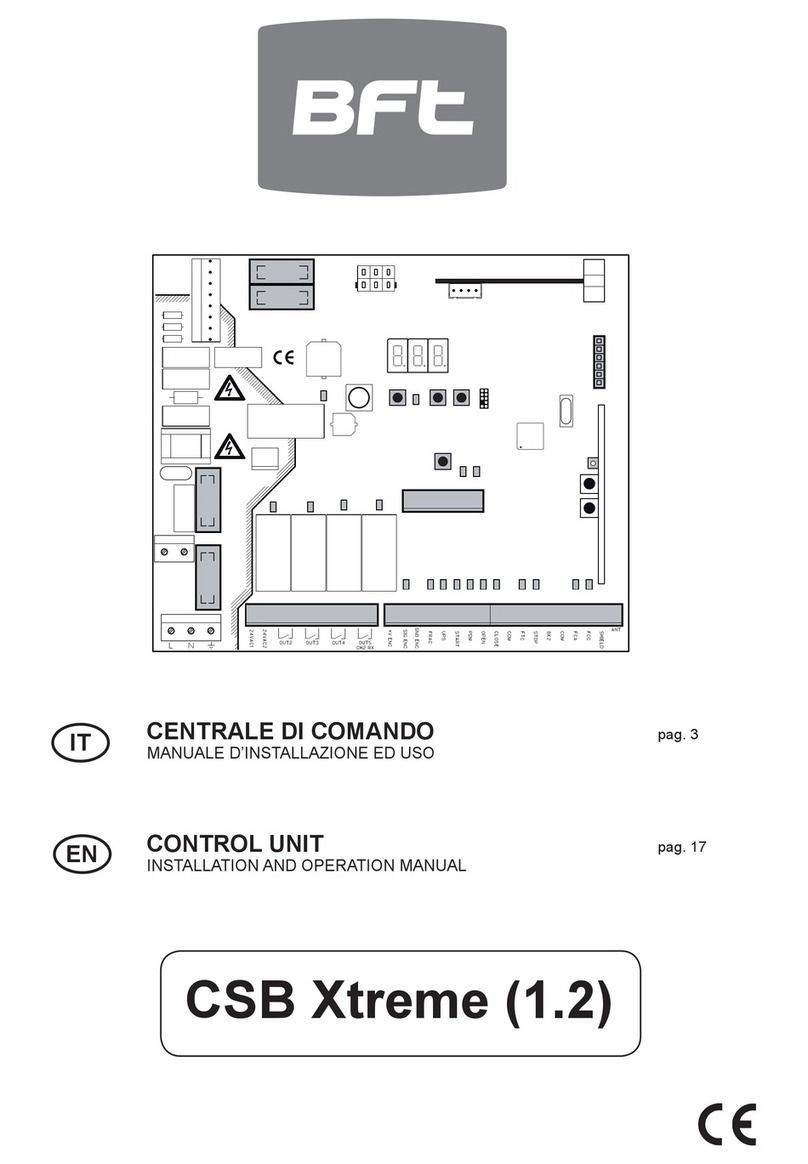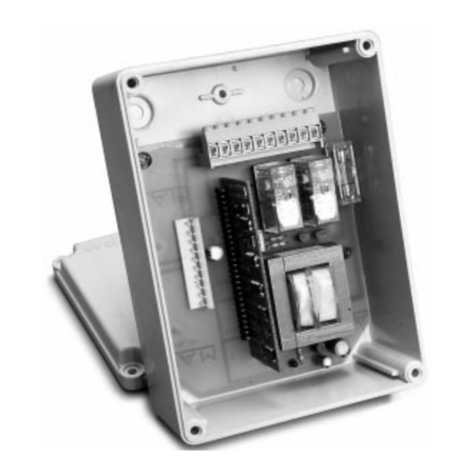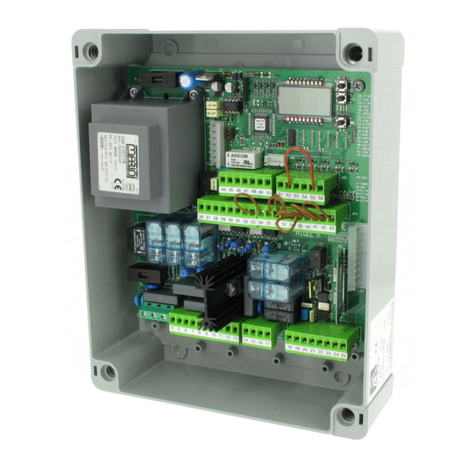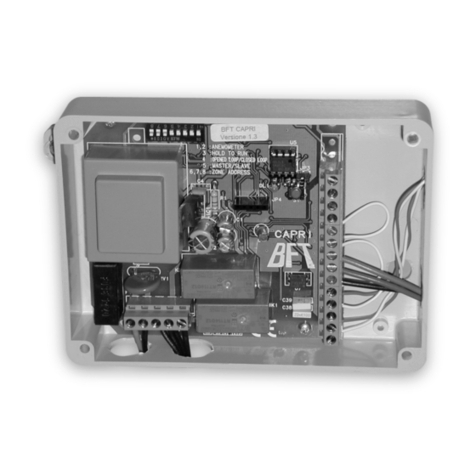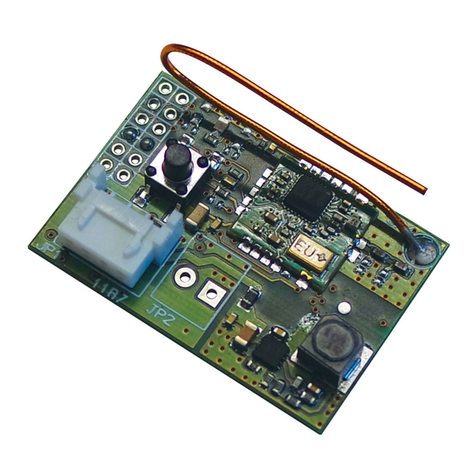
MANUALE PER L’INSTALLAZIONE
ITALIANO
11 - Contatto N.O. OPEN (comanda un’apertura manuale della
porta).
12 - Contatto DOOR (ingresso stato porta) NC-PORTA CHIUSA
NO PORTA APERTA.
Rileva lo stato della porta necessario per individuare la condizio-
ne di allarme, se non utilizzato lasciare il ponticello inserito).
JP2 (connessione COMPASS-READER)
13 - + Alimentazione
14 - Data 1
15 - Data Ø
16 - GND
17 - LED A
18 - LED B
Riceve dal COMPASS-READER i dati della tessera presentata.
E’ possibile collegare un massimo di 2 COMPASS-READER ad
ogni COMPASS-485 (Fig. 3).
5) GENERARAZIONE DELLE MASTER CARD
Il sistema è gestito da tre Master Card (Master Card +, Master Card
-, Master Card Jolly) che consentono di abilitare o disabilitare le
tessere e configurare il funzionamento dell’accesso come indicato
al paragrafo “Configurazione Parametri e Gestione Tessere”
Per generare queste Master Card seguire questa procedura:
1 Aprire la scatola COMPASS-485
2 Mettere in ON il Dip Switch 6 (Fig.3)
3 Presentare una Card Standard (il led lampeggia rosso-verde)
4 Mettere in Off il Dip 6
5 Ora la Card è una Master Card +, applicare l’apposito adesivo
(colore verde, simbolo +) fornito in dotazione, che identificherà
il tipo di Master Card.
6 Mettere in ON il Dip Switch 7 (Fig.3)
7 Presentare una Card Standard (il led lampeggia rosso-verde)
8 Mettere in Off il Dip 7
9 Ora la Card è una Master Card -, applicare l’apposito adesivo
(colore rosso, simbolo -) fornito in dotazione, che identificherà
il tipo di Master Card.
10 Mettere in ON il Dip Switch 8 (Fig.3)
11 Presentare una Card Standard (il led lampeggia rosso-verde)
12 Mettere in Off il Dip 8
13 Ora la Card è una Master Card Jolly, applicare l’apposito
adesivo (colore giallo, simbolo Jolly) fornito in dotazione, che
identificherà il tipo di Master Card.
14 Chiudere la scatola COMPASS-485
Con le Master Card è quindi possibile procedere alla configura-
zione del sistema.
Al termine dell’utilizzo, riporre le Master Card e le presenti istruzioni
in un luogo sicuro e conosciuto solo alle persone interessate.
6) CONFIGURAZIONE PARAMETRI E GESTIONE TESSERE
La configurazione di parametri e l’abilitazione delle tessere avviene
tramite la presentazione in sequenza delle Master Card e delle tes-
sere da abilitare o disabilitare secondo la seguente procedura:
• Abilitazione Tessera:
Presentare al lettore la Master Card + (il led lampeggia
rosso-verde) seguita dalla tessera da abilitare all’accesso
(il led commuta giallo)
• Disabilitazione Tessera:
Presentare al lettore la Master Card - (il led lampeggia
rosso-verde) seguita dalla tessera da disabilitare all’accesso
(il led commuta giallo)
Nel caso sia necessario disabilitare una tessera smarrita
sono possibili due soluzioni:
• Se il sistema è gestito da Securbase e si conosce il codice
della tessera (tutte le tessere riportano stampigliato un
codice formato da 6 cifre), è possibile la disabilitazione
via software della tessera, digitando nell’apposito menu il
codice da disabilitare.
• Se il sistema non è gestito da Securbase o non si conosce
il codice della tessera è necessario provvedere alla disa-
bilitazione di tutte le tessere e la successiva riabilitazione
delle tessere valide.
• Accesso Libero (porta sempre aperta):
Presentare al lettore la Master Card Jolly (il led lampeggia rosso-
verde) seguita dalla Master Card + (il led commuta verde).
• Accesso Vietato (porta sempre chiusa):
Presentare al lettore la Master Card Jolly seguita dalla
Master Card - (il led commuta rosso)
• Accesso con funzionamento normale
(apertura solo con card memorizzate):
Presentare al lettore per 2 volte consecutive la Master
Card Jolly (il led commuta giallo).
• Impostazione Tempo Attrazione Relè Porta:
Presentare al lettore la Master Card + (il led lampeggia
rosso-verde) seguita dalla Master Card Jolly (il led lampeg-
gia verde), da questo momento ogni successivo passaggio
della Master Card Jolly incrementa il valore, espresso in
secondi, del tempo di attrazione del relè porta.
I valori in sequenza sono i seguenti: 0,1,2,3,4,5,6,7,8,9,1
0,11,12,13,14,15,16,17,18, 19,20,21,22,23,24,25. Dopo il
valore 25 che equivale a 25s, si torna al valore 0.
Se il valore impostato è 0 il relè di apertura porta resta
attratto finchè la porta non viene richiusa.
• Impostazione Tempo Controllo Porta:
Presentare al lettore la Master Card - (il led lampeggia
rosso-verde)seguita dalla Master Card Jolly (il led lampeg-
gia rosso), da questo momento ogni successivo passaggio
della Master Card Jolly incrementa il valore, espresso in
secondi, del tempo di controllo porta.
I valori in sequenza sono i seguenti: 0,10,20,30,40,50,60,
70,80,90,100,110,120,130,140,150, 160,170,180,190,20
0,210,220,230,240,250. Dopo il valore 250 che equivale
a 250s, si torna al valore 0.
Se il valore impostato è 0 il controllo porta è disabilitato.
Controllo porta:
Esegue il controllo dello stato porta utilizzando l’ingresso
contatto “DOOR”, verificando che a seguito della chiusura
del relè di apertura porta, la porta venga effettivamente
aperta e successivamente richiusa.
Se non avviene l’apertura dopo il “tempo controllo porta”
avviene la commutazione del relè l’allarme.
Se la porta viene aperta deve essere richiusa entro il “tempo
controllo porta”, altrimenti effettua la commutazione del
relè allarme.
• Reset del sistema:
ATTENZIONE! con questa procedura si cancellano
tutte le tessere abilitate e le Master card; i parametri
di funzionamento restano memorizzati.
Presentare per 3 volte consecutive la Master Card - (il led
lampeggia rosso-giallo). La cancellazione richiede circa 90 s.
NOTA: Dopo la presentazione di una Master Card, il sistema
resta in attesa di una tessera successiva per 3 secondi, trascorsi
i quali, il sistema torna al funzionamento normale.
7) CONFIGURAZIONE DIP SWITCH
Il controllo COMPASS-485 è dotato di 8 dip-switch, configu-
rabili ON - OFF:
I Dip 1-2-3-4-5 consentono di impostare l’indirizzo di comunicazione (pol-
ling) del Compass-485 nel caso di utilizzo con Compass-232 e PC.
Ad es: tutti i Dip Off = indirizzo 0, solo Dip1 On = Indirizzo 1, solo
Dip 4 On= indirizzo 8, Dip 1+2+5 On= 19.
Sono validi solo gli indirizzi compresi tra 0 e 19 e nel caso di
connessione di più Compass-485 è indispensabile che l’indirizzo
sia univoco, per evitare conflitti (Fig.4).
10 - COMPASS-485/232 - Ver. 04
D811320_04


